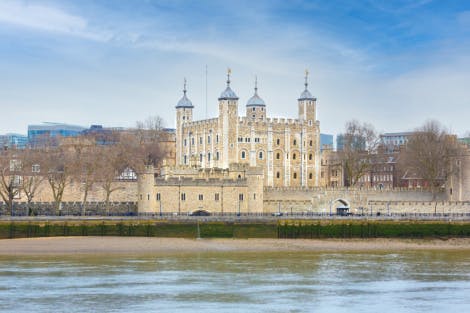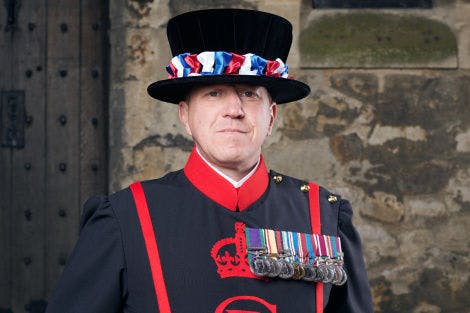'Washing the Lions': A Famous April Fools Hoax at the Tower of London
Date: 01 April 2024
For hundreds of years, being sent to the Tower of London was no laughing matter. But did you know that this ancient fortress is also home to Britain’s earliest recorded April Fool’s prank – the so-called 'Annual Ceremony of Washing the Lions'?
Here, Assistant Curator Minette Butler explores how the Tower’s lions became unwitting accomplices to London’s favourite practical joke.
Lions at the Tower
Founded by King John in the early 13th century, the Tower menagerie was home to the many creatures gifted to the monarchy. These royal beasts included everything from tigers, snakes, elephants, baboons and even possibly a polar bear.
Since the reign of Edward I, lions and other royal beasts were kept in the now lost ‘Lion Tower’, once found near the Middle Tower entrance over the moat (sometimes called the Tower Ditch).
Between 1604 and 1606, James I expanded the animals’ enclosures to give visitors a better view of the big cats. This included building an exercise yard, a viewing platform and a ‘greate cistern… for the Lyons to drinke and washe themselfes in’.

Image: Illustration of one of the Tower lions from a history of the menagerie written by Edward Turner Bennett, Vice-Secretary of the Zoological Society of London shortly before the removal of the animals from the Tower to Regent’s Park in the 19th century. © Historic Royal Palaces

Image: The Lion Tower, now almost destroyed, derived its name from the 1330s when it housed the lions in the King's royal menagerie. © Historic Royal Palaces
Lions became one of the Tower’s most popular attractions. Often named after kings, queens and other historic figures, these impressive animals were heavily associated with British identity and had been incorporated into royal arms since the reign of Richard I. They were also dangerous; in 1686, a woman named Mary Jenkinson died after trying to stroke a lion’s paw.
Nonetheless, lions were kept and even bred at the Tower for over 600 years. For some, the phrase 'going to see the lions' was synonymous with visiting London and seeing the city’s famous sights.
The Origins of a Famous 'April Fool'
Historians still debate about the origins of April Fool’s Day – a tradition continued every year on 1 April. English references to playing hoaxes – therefore making someone an ‘April fool’ – begin in the early 17th century, with antiquarian John Aubrey first attributing ‘All Fool’s Day’ to 1 April in 1686.
From the late 17th to mid-19th centuries, sending someone to watch the ‘Washing of the Lions’ was London’s favourite fool’s errand – often given to rural and international visitors on the first day of April.
Transcribed in Notes and Queries (1913), Dawk’s Newletter reported in 1698 that ‘yesterday being the first of April, several persons were sent to the Tower Ditch to see the Lions washed’. Many historians consider this to be the oldest recorded April Fool’s Day hoax.
Time was when amongst the lions of London the lions in the Tower held a distinguished rank… so high indeed was their reputation, the washing of the Lions at the Tower formed one of the standing jokes of the 1st of April.
Berkshire Chronicle, 1825
Tales from the Tower
Stories of unwitting tourists being sent to the Tower appear in journals, newspapers, and memoirs.
Most who asked after the lions came away relatively unscathed. One Scottish visitor remembered joining his friend to ‘see the Lions washed’ only to reach the Tower and find ‘all the rascals laughing at us’.
But not all victims were so lucky. One gossipy account appears in a ‘Home News’ entry from The Lady’s Magazine, dated 1771. After asking what time the lions would be washed, two men were encouraged into a small boat on the nearby river to get a better view of the ceremony.
Once safely aboard, the pair were stripped of their oars and pushed out onto the Thames. Helpless and adrift, they were soon surrounded by other mischievous boats who ‘splashed by them for about a quarter of an hour, to the great diversion of the spectators’.

Image: The Tower of London viewed from the River Thames, by an unknown artist. © Historic Royal Palaces
What's So Funny?
Historians still aren’t sure where this ‘washing the lions’ hoax came from, although some speculate that the prank grew from visitors tipping menagerie keepers for tours or to feed the animals.
Lions were some of the first animals kept at the Tower. However, a distinct ‘Ceremony of Washing the Lions’ seems to have been a complete fiction – maybe, as one wry commentator observed in 1873, because ‘the washing of lions is a disagreeable and dangerous process’.
The Joke Endures
The menagerie went into decline from the 1820s, with the animals gradually sold off to various collections including what later became London Zoo. The famous home of the nation’s royal beasts finally closed in 1835.
Yet the joke outlived the lions themselves. In his memoirs, Gustave Louis M Strauss confessed to handing out tickets for the ‘famous grand ceremony of washing the lions’ in around 1848. Organised by the owner and editor of the Chat, a London-based comic magazine, Strauss colourfully recalls how people ‘flocked in their shoals to see the lions washed’ and that ‘the “warders” were almost at their wits’ end’.
A printer of ballads, not many years back, tried to make a little money by a smart bit of April Fooling. Knowing that many country people are still ignorant of the fact that the lions have been long removed from the Tower, he printed penny tickets purporting to admit the holder to the annual ceremony of washing the lions... How many ninnies were taken in by the trick, the record does not say.
Chamber’s Journal, 1877

Image: Sculpture of a lion, installed on the site of the Lion Tower as part of the Royal Beasts exhibition. © Historic Royal Palaces
In 1860, ‘a vast multitude of people’ received yet more tickets to witness the ‘Ceremony of Washing the White Lions’. According to Chamber’s Book of Days (1863), the prank was remembered as ‘highly successful’ with a host of cabs descending on Tower Hill in search of the still non-existent White Gate.
The Last Laugh
A strange story from one of the lesser-known chapters in the Tower’s history, this April Fool’s hoax is a small window into a bustling city’s sense of humour.
Today, the only lions left at the Tower of London are these sculptures, created by Artist Kendra Haste and placed near the site of the lost Lion Tower. Although the lions may be long gone, visitors can still come face to face with one of our grizzly bears!
Minette Butler
Assistant Curator, Historic Royal Palaces
More from our blog

Elizabeth I’s coronation procession from the Tower of London
17 November 2022
Curator Charles Farris recalls Elizabeth’s dramatic procession from the Tower of London to Westminster the day before her coronation.

A Year in the Life of a New Yeoman Warder
27 October 2023
By tradition, only 422 people have ever held the role of Yeoman Warder at the Tower of London. Here, Yeoman Warder Simon Towe, who joined the ranks of the Yeoman Body in November 2022, shares an eventful first year in his new life.

Anthony Salvin: the architect who transformed the Tower of London
16 December 2021
Archivist Tom Drysdale introduces Anthony Salvin, the Victorian architect who began the transformation of the Tower of London, and looks at four drawings that shed a light on his work and legacy.

